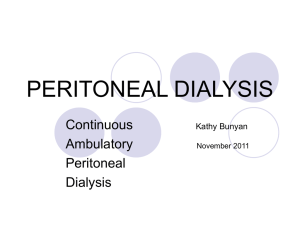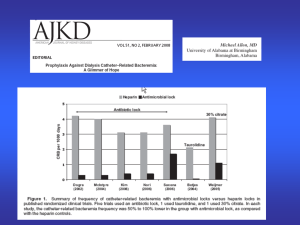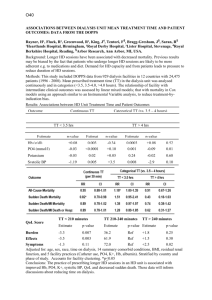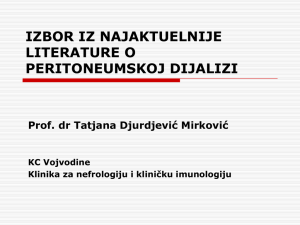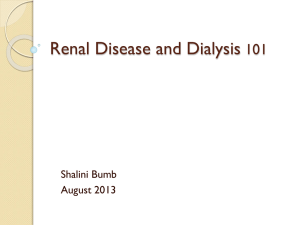Cornelis H. Schröder
advertisement
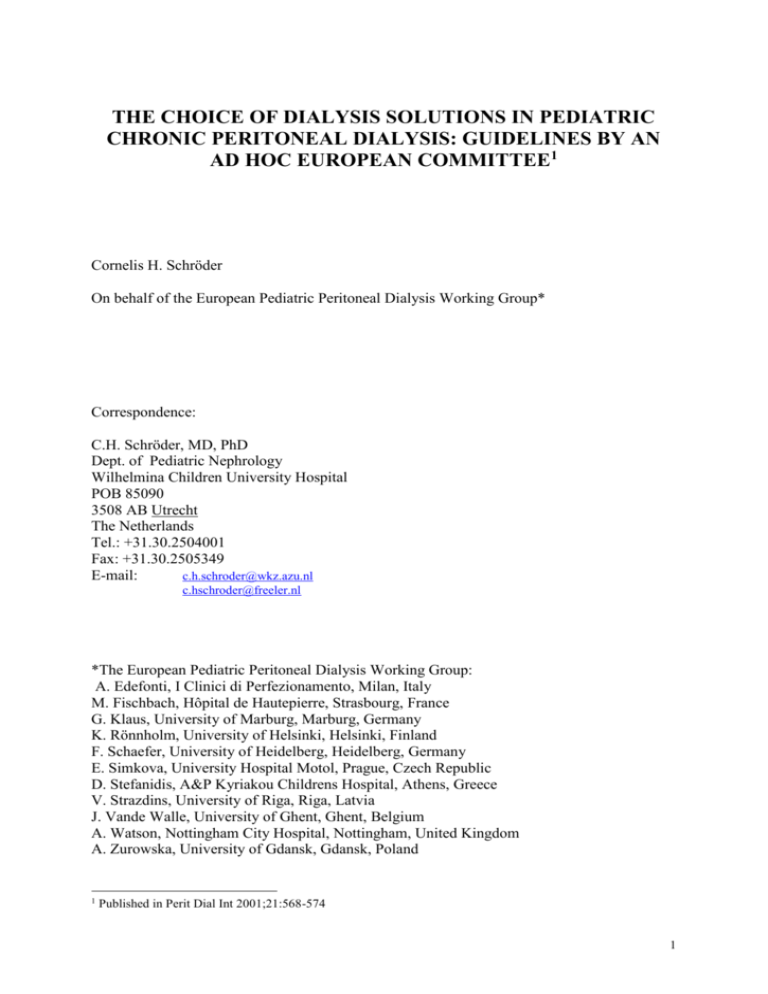
THE CHOICE OF DIALYSIS SOLUTIONS IN PEDIATRIC CHRONIC PERITONEAL DIALYSIS: GUIDELINES BY AN AD HOC EUROPEAN COMMITTEE1 Cornelis H. Schröder On behalf of the European Pediatric Peritoneal Dialysis Working Group* Correspondence: C.H. Schröder, MD, PhD Dept. of Pediatric Nephrology Wilhelmina Children University Hospital POB 85090 3508 AB Utrecht The Netherlands Tel.: +31.30.2504001 Fax: +31.30.2505349 E-mail: c.h.schroder@wkz.azu.nl c.hschroder@freeler.nl *The European Pediatric Peritoneal Dialysis Working Group: A. Edefonti, I Clinici di Perfezionamento, Milan, Italy M. Fischbach, Hôpital de Hautepierre, Strasbourg, France G. Klaus, University of Marburg, Marburg, Germany K. Rönnholm, University of Helsinki, Helsinki, Finland F. Schaefer, University of Heidelberg, Heidelberg, Germany E. Simkova, University Hospital Motol, Prague, Czech Republic D. Stefanidis, A&P Kyriakou Childrens Hospital, Athens, Greece V. Strazdins, University of Riga, Riga, Latvia J. Vande Walle, University of Ghent, Ghent, Belgium A. Watson, Nottingham City Hospital, Nottingham, United Kingdom A. Zurowska, University of Gdansk, Gdansk, Poland 1 Published in Perit Dial Int 2001;21:568-574 1 Abstract Objective: To provide guidelines on the choice of dialysis solutions in children on chronic peritoneal dialysis. Setting: European Pediatric Peritoneal Dialysis Working Group (EPPWG) Data source: Literature on the application of peritoneal dialysis solutions in children (evidence) and discussions within the group (opinion). Conclusions: Glucose is the standard osmotic agent for peritoneal dialysis in children (evidence). The lowest glucose concentration needed should be used (opinion). Low calcium solution (1.25 mmol/L) should be applied, wherever possible, with careful monitoring of parathyroid hormone levels (opinion). The use of amino acids containing dialysis fluids can be considered in malnourished children, although aggressive enteral nutrition is preferred (opinion). There is insufficient evidence documenting the efficacy of intraperitoneally administered amino acids (evidence). Polyglucose solutions are a welcome addition to the treatment of children on NIPD, when ultrafiltration and/or solute removal are insufficient (evidence). However, in the absence of any reported long-term experience in children their use must be closely monitored (opinion). Bicarbonate would appear to be the preferred buffer for peritoneal dialysis in children, but more in vivo studies are required before it replaces the present lactate containing solutions (evidence/opinion). Running title: PD fluids in children Key words: peritoneal dialysis solutions, children, glucose, calcium, amino acids, icodextrin, bicarbonate. 2 Commencing chronic peritoneal dialysis in an individual child requires the choice of an appropriate dialysis solution from the large number that are available. The choice is usually straightforward in a child commencing dialysis, but the choice of solution is more important and difficult in the case of patients with complications, such as ultrafiltration failure and malnutrition. In addition to the traditional glucose solutions there are now a number of different osmotic agents and buffers available. The European Pediatric Peritoneal Working Group (EPPWG) was established in 1999 by pediatric nephrologists with a major interest in peritoneal dialysis and has already initiated guidelines on commencing elective chronic peritoneal dialysis [1]. One of the functions of the group is to establish expert guidance in important clinical areas associated with peritoneal dialysis in conjunction with other members of the multidisciplinary team. These guidelines were initiated and discussed at meetings of the group and developed by e-mail discussion to develop consensus of opinion based upon cumulative clinical experience and reported studies. This paper will discuss the advantages and disadvantages of the dialysis solutions available and highlight any reported pediatric experience, and provides recommendations for the choice. Attempts have been made to base these recommendations on evidence obtained from the published literature. It should be kept in mind, however, that the number of available pediatric studies in this field and the size of these studies does not allow development of evidence-based recommendations on a firm basis. Multicenter studies on a larger scale have to be conducted to provide more evidence for the recommendations. Osmotic agents 3 Glucose From the start of peritoneal dialysis as a therapy for renal failure glucose has been used as the osmotic agent. Table I gives information on the composition and some properties of conventional dialysis solutions commonly prescribed. The low pH and the high osmolarity are prominent characteristics. The high osmolarity of conventional dialysis solutions is caused by the glucose content. The low pH of these solutions will be discussed later in this paper. The high glucose concentration gives rise to a high glucose absorption, adding calories to the patient on the one hand, but causing hyperlipidemia and hyperinsulinemia on the other. A large number of studies, both in vitro and in vivo, have been published proving detrimental effects of these solutions on the (intra)peritoneal cells. These effects have recently been extensively reviewed by Krediet et al [2]. Mesothelial cells are inhibited with respect to their proliferation and cytokine production [3-5]. In vitro research demonstrated necrosis of human monocytes after exposure to dialysis solutions [6]. The high glucose concentration in the dialysis solution leads to irreversible glycosylation of proteins [7-9]. Subsequently, glucose degradation products and advanced glycosylation end products are formed, which may contribute to the functional deterioration of the peritoneal membrane in long-term dialysis [10-13]. These products have been shown to affect cellular growth and induce functional changes in monocytes and neutrophils. In order to avoid the possibility of functional deterioration of the peritoneal membrane due to the high glucose content and low pH of these solutions, the solution with the lowest glucose should be used in daily practice. Regular assessment of both dietary fluid intake and urinary output should be performed. In infants high glucose concentrations can rapidly lead to dehydration and their use needs careful supervision. 4 Because of the unfavorable properties of glucose as an osmotic agent a number of alternative osmotic agents have been studied and will be discussed later. Experience with some of these solutions is limited, particularly with respect to specific pediatric data. A few remarks have to be made on the calcium content of the dialysis fluid. The standard calcium concentration is 1.75 mmol/L (Table I). The use of dialysis solutions containing this concentration frequently leads to hypercalcemia if patients are simultaneously treated with Ca-containing phosphate binders and vitamin D analogs. Therefore, low calcium dialysis solutions (1.25 mmol/l) have been developed, aiming to allow higher dosage of oral phosphate-binding calcium salts, and to minimize hypercalcemia. Although the experience in children with these solutions is very limited [14], the results and the experience from adult studies confirm this theory [15-17]. On the contrary, it should be remembered that in adult patients there is a certain risk that severe secondary hyperparathyroidism with long-term lowcalcium therapy will develop, even if normocalcemia is obtained [18-20]. In children a slightly positive calcium balance might be needed because of the growing skeleton. Although there is no specific pediatric literature on this topic, it can be assumed that this may also occur in children. Recommendation Glucose is the standard osmotic agent for peritoneal dialysis in children. (evidence) The lowest glucose concentration needed should be used. (opinion) Low calcium solution (1.25 mmol/L) should be applied, wherever possible, with careful monitoring of parathyroid hormone levels at least every 3 months. (opinion) Amino acids 5 Amino acids, administered once daily for a 4-6 hour dwell, are claimed to supply nutrition to dialysis patients and to compensate for peritoneal protein losses [21-26]. Although in these studies statistically significant rises in serum albumin, pre-albumin, transferrin, and mid arm muscle circumference have been reported, it is still to be established that amino acids contribute to an improved long-term nutritional status. Conversely, amino acids tend to worsen acidosis and to increase urea load. The composition of the only presently available preparation is given in Table II. There are a number of publications describing the experience with amino acid solutions in children [27-31]. The most extensive studies have been performed by Canepa and colleagues. In a study in 8 children for a period of 6 months, in which the amino acid solution was mixed with a glucose solution in a continuous peritoneal dialysis (CPD) regimen, an improvement of anthropometric parameters, like mid arm circumference and weight-for height percentile occurred [30]. There were no modifications in blood urea nitrogen levels, nor in serum levels of total proteins and albumin. The authors concluded that the main advantages of administering supplemental amino acids by the peritoneal route are the good compliance without modification of the normal dialysis procedure, and the fact that the supplemental nitrogen by amino acids carries no additional phosphorus. Especially this latter property seems to be important, since phosphate control in children is often a problem, partly caused by the relatively high protein intake. Amino acid dialysis solutions are relatively expensive. Whenever possible, the enteral route is preferred to correct malnutrition. Recommendation The use of amino acid containing dialysis fluids can be considered in malnourished children, although aggressive enteral nutrition is preferred. (opinion) There is insufficient evidence documenting the efficacy of intraperitoneally administered amino acids. (evidence) 6 Polyglucose Polyglucose solutions have been extensively studied both in adults and in children. The commercially available polyglucose solution (icodextrin 7.5%) contains glucose polymers with an average molecular weight of 16,200 D. The composition and some of the properties are given in Table III. Because of the low adsorption of these large-molecular weight substances ultrafiltration is sustained making icodextrin very suitable for long-time dwell periods [32-34]. In adult patients improved ultrafiltration during a day-time dwell was obtained with icodextrin compared to glucose 1.36% [35]. De Boer et al. studied the effects of icodextrin in 11 children who were being treated with a NIPD (nightly intermittent peritoneal dialysis) regimen [36]. Icodextrin was compared with glucose 1.36% and glucose 3.86% for a 12-hour dwell period. Net ultrafiltration obtained with the icodextrin solution was similar to that obtained with the glucose 3.86% solution, and significantly higher than that observed with the glucose 1.36% solution. In these children the daily administration of icodextrin added a mean of 0.52 (standard deviation 0.07) to weekly KT/V urea, because of the longer time on dialysis. The sustained but slow ultrafiltration is illustrated by the absence of a drop of dialysate sodium concentration in the group treated with icodextrin, a phenomenon normally occurring in patients treated with 3.86% glucose, who are presumed to have a normally functioning peritoneal membrane [37,38]. In the 4-hour peritoneal equilibration test net ultrafiltration is much lower than using a glucose 3.86% glucose solution [39]. The potential toxicity of icodextrin solutions has been studied both in adults and in children and has provided similar results [32,36,40]. In a study in which icodextrin was 7 prescribed for the daytime dwell in children on NIPD for 6 weeks, icodextrin blood levels rapidly increased to a steady state reached after 2 weeks [36]. Two weeks after the discontinuation of the study icodextrin was not detectable in the blood anymore. Blood levels of the main metabolites of icodextrin (maltose, maltotriose, and maltotetraose) followed a similar pattern. Concentrations were identical to those measured in adult patients [32,40]. In some patients hypersensitivity reactions towards icodextrin have been reported [41-43]. In the one pediatric study a hypersensitivity reaction was observed in one out of 11 patients [36]. In adult patients long-term experience with icodextrin is increasing; in children this is still very limited. Recommendation Polyglucose solutions are a welcome addition to the treatment of children on NIPD, when ultrafiltration and/or solute removal are insufficient. (evidence) However, in the absence of any reported long-term experience in children their use must be closely monitored. (opinion) Other osmotic agents Although literature is available on the use of glycerol [44-48] and oligopeptides [4951] as an osmotic agent, their application is still considered experimental. Dialysis fluids containing these agents are not commercially available and hence they are not recommended for application in children. Buffers 8 Acetate Acetate, which was the standard buffer in the early peritoneal dialysis solutions, has been completely abolished because of its strong association with the development of sclerosing peritonitis [52,53]. Lactate Lactate is currently the standard buffer applied in dialysis solutions. Lactate was chosen because solutions containing mixtures of bicarbonate, calcium, and glucose cause the formation of insoluble calcium salts. Under normal conditions lactate is regularly metabolized, but is stimulates collagen synthesis by fibroblasts. On the other hand sterilizing these solutions at physiological pH leads to caramelization of glucose. Therefore pH of standard peritoneal dialysis solutions varies between 5.0 and 6.5 (Table I). Bicarbonate The number of reports using bicarbonate as a more physiological buffer is increasing. This can only be done if a double bag is created, one side containing glucose and calcium, and the other containing sodium bicarbonate. These bags have to be mixed shortly before administration. Bicarbonate buffered solutions have a more physiological pH (7.0-7.6) than lactate-based solutions (5.5-6.5). The composition and some of the properties of three commercially available bicarbonate or bicarbonate/lactate dialysis solutions is given in Table IV. Most of the studies performed with these solutions report positive results, when compared to lactate-buffered dialysis solutions [54-56]. In vitro studies showed markedly 9 better preserved function of both macrophages and human peritoneal mesothelial cells [5761]. An effective control of acid base balance is demonstrated by several in vivo studies [6266]. An interesting property of this solution is the lower incidence of infusion pain [67]. Infusion pain is generally agreed to be due to the acidity of the conventional solutions. Studies in adult patients demonstrate a clear reduction of infusion pain and discomfort. This property is particularly important for some children. Although there is experience in the pediatric dialysis centers using custom-made bicarbonate dialysis solutions in cases with lactate acidosis, no papers have been published on the chronic use and effects of bicarbonate-based peritoneal dialysate [68]. It is known that inflow pain can be treated by pH adjustment of the dialysis fluid with bicarbonate [69]. Since in pediatric dialysis dwell times usually are very short, the application of a pH-neutral, bicarbonate-based solution seems to be indicated. The pediatric experience is only published in abstract-form [70,71]. In one study 5 children were switched from lactate to bicarbonate containing dialysis solutions [70]. The duration of the study was not mentioned. No differences with respect to adequacy, ultrafiltration, or laboratory values were established for the two periods, but there was an important decrease in abdominal pain during the filling phase, with a concomitant lower intraperitoneal pressure. The second study was devoted to the characteristics of bicarbonate dialysis fluid in a peritoneal equilibration test [71]. In 25 children peritoneal fluid kinetics and solute transport were similar to the results obtained using traditional lactate dialysis fluid. Intraperitoneal pH was significantly lower during the first hour with the latter dialysis fluid. More studies in pediatric patients are urgently needed. 10 Recommendation Bicarbonate would appear to be the preferred buffer for peritoneal dialysis in children, but more in vivo studies are required before it replaces the present lactate based solutions. (evidence/opinion) Conclusion Since the preferred treatment modality in children is NIPD, dwell times are usually short [72]. This makes the application of a pH-neutral dialysis solution for the standard nightly prescription highly desirable. If ultrafiltration and/or KT/V urea are insufficient using this regimen, the addition of a long day-time dwell with polyglucose solutions should be considered. The place of amino acid containing dialysis fluids in pediatric peritoneal dialysis still has to be determined. 11 References 1. Watson AR, Gartland C on behalf of the European Pediatric Peritoneal Working Group. Elective chronic peritoneal dialysis in pediatric patients: Guidelines by an ad hoc European committee. Perit Dial Int (in press). 2. Krediet RT, Zweers MM, Ho-dac-Pannekeet MM, Van der Wal AC, Smit W, Douma CE et al. The effect of various dialysis solutions on peritoneal membrane viability. Perit Dial Int 1999 ;19 (Suppl 2):257-66. 3. Breborowicz A, Rodela H, Oreopulos DG. Toxicity of osmotic agents on human mesothelial cells in vitro. Kidney Int 1992;41:1280-5. 4. Topley N, Coles GA, Williams JD. Biocompatibility studies on peritoneal cells. Perit Dial Int 1994;14(suppl.3):21-8. 5. Yung AH, Chen JY, Lin YP, Huang TP, Wu CW. Peritoneal dialysis solution induces apoptosis of mesothelial cells. Kidney Int 1997;51:1280-8. 6. Plum J, Lordnejad MR, Grabensee B. Effect of alternative peritoneal dialysis solutions on cell viability, apoptosis/necrosis and cytokine expression in human monocytes. Kidney Int 1998;54:224-35. 7. Plum J, Schoenicke G, Grabensee B. Osmotic agents and buffers in peritoneal dialysis solution: Monocyte cytokine release and in vitro cytotoxicity. Am J Kidney Dis 1997;30:413-22. 8. Ho-dac-Pannekeet MM, Weiss MF, De Waart DR, Erhard P, Hiralall JK, Krediet RT. Analysis of non enzymatic glycosylation in vivo: Impact of different dialysis solutions. Perit Dial Int 1999;19(suppl.2):68-74. 9. Lameire N, Van Biesen W, Vanholder R. Consequences of using glucose in peritoneal dialysis fluid. Sem Dial 1998;11:271-5. 12 10. Linden T, Forsbäck G, Deppisch R, Henle T, Wieslander A. 3-deoxyglucosone, a promoter of advanced glycation end products in fluids for peritoneal dialysis. Perit Dial Int 1998;18:290-3 11. Schalkwijk CG, Posthuma N, Ten Brink HJ, Ter Wee PM, Teerlink T. Induction of 1,2-dicarbonyl compounds, intermediates in the formation of advanced glycation endproducts, during heat-sterilization of glucose-based peritoneal dialysis fluids. Perit Dial Int 1999;19:325-33. 12. Raj DSC, Choudhury D, Welbourne TC, Levi M. Advanced glycation end products: A nephrologist’s perspective. Am J Kidney Dis 2000;35:365-80. 13. Witowski J, Korybalska K, Wisniewska J, Breborowicz A, Gahl GM, Frei U et al. Effect of glucose degradation products on human peritoneal mesothelial cell function. J Am Soc Nephrol 2000;11:729-39. 14. Coulthard MG. Control of hyperparathyroidism in children using peritoneal dialysis solutions with low or zero concentrations of calcium. Nephrol Dial Transplant 1992;7:652-3 (letter). 15. Weinreich T, Passlick-Deetjen J, Ritz E, for the Collaborators of the Peritoneal Dialysis Multicenter Study Group. Low dialysate calcium in continuous ambulatory peritoneal dialysis: A randomised controlled multicenter trial. Am J Kidney Dis 1995;25:452-60. 16. Hutchison AJ, Were AJ, Boulton HF, Mawer EB, Laing I, Gokal R. Hypercalcaemia, hypermagnesaemia, hyperphosphataemia and hyperaluminaemia in CAPD: Improvement in serum biochemistry by reduction in dialysate calcium and magnesium concentrations. Nephron 1996;72:52-8. 13 17. Bro S, Brandi L, Daugaard H, Olgaard K. Calcium concentration in the CAPD dialysate: What is optimal and is there a need to individualize? Perit Dial Int 1997;17:554-9. 18. Duncan R, Cochrane T, Bhalla C, Michael J, Richards NT, Adu D. Low calcium dialysate and hyperparathyroidism. Perit Dial Int 1996;16 (Suppl 1):499-502. 19. Buijsen CGM, Struijk DG, Huijgen HJ, Boeschoten EW, Wilmink JM. Can lowcalcium peritoneal dialysis solution safely replace the standard calcium solution in the majority of chronic peritoneal dialysis patients? Perit Dial Int 1996;16:497-504. 20. Weinreich T, Ritz E, Passlick-Deetjen J, for the Collaborators of the Multicenter Study Group. Long-term dialysis with low-calcium solution (1.0 mmol/L) in CAPD: Effects on bone mineral metabolism. Perit Dial Int 1996;16:260-8. 21. Kopple JD, Bernard D, Messana J, Swartz R, Bergström J, Lindholm B et al. Treatment of malnourished CAPD patients with an amino acid based dialysate. Kidney Int 1995;47:1148-57. 22. Jones M, Hagen T, Algrim Boyle C, Vonesh E, Hamburger R, Charytan C et al. Treatment of malnutrition with 1.1% amino acid peritoneal dialysis solution: Results of a multicenter outpatient study. Am J Kidney Dis 1998;32:761-9. 23. Jones MR, Gehr TW, Burkart JM, Hamburger RJ, Kraus AP, Piraino BM et al. Replacement of amino acid and protein losses with 1.1% amino acid peritoneal dialysis solution. Perit Dial Int 1998;18:210-6. 24. Gregorzewska AE, Mariak I, Dobrowolska-Zachwieja A, Szajdak L. Effects of amino acid dialysis solution on the nutrition of continuous ambulatory peritoneal dialysis patients. Perit Dial Int 1999;19:462-70. 25. Shockley TR, Martis L, Tranæus AP, New solutions for peritoneal dialysis in adult and pediatric patients. Perit Dial Int 1999;19(suppl.2):429-34. 14 26. Wolfson M, Jones M. Intraperitoneal nutrition. Am J Kidney Dis 1999;33:203-4. 27. Canepa A, Perfumo F, Carrea A, Giallongo F, Verrina E, cantaluppi A et al. Longterm effect of amino-acid dialysis solution in children on continuous ambulatory peritoneal dialysis. Pediatr Nephrol 1991;5:215-9. 28. Honda M, Kamiyama Y, Hasegawa O, Hoshinaga K, Ogawa O, Kawamura T et al. Effect of short-term essential amino acid-containing dialysate in young children on CAPD. Perit Dial Int 1991;11:76-80. 29. Qamar IU, Levin L, Balfe JW, Balfe JA, Secker D, Zlotkin S. Effects of 3-month amino acid dialysis compared to dextrose dialysis in children on continuous ambulatory peritoneal dialysis. Perit Dial Int 1994;14:34-41. 30. Canepa A, Verrina E, perfumo F, Carrea A, Menoni S, Delucchi P et al. Value of intraperitoneal amino acids in children treated with chronic peritoneal dialysis. Perit Dial Int 1999;19(suppl.2):435-40. 31. Qamar IU, Secker D, Levin L, Balfe JA, Zlotkin S, Balfe JW. Effects of amino acid dialysis compared to dextrose dialysis in children on continuous cycling peritoneal dialysis. Perit Dial Int 1999;19:237-47. 32. Mistry CD, Gokal R, Peers E, MIDAS Study Group. A randomized multicenter clinical trial comparing isosmolar icodextrin with hyperosmolar glucose solutions in CAPD. Kidney Int 1994;46:496-503. 33. Woodrow G, Stables G, Oldroyd B, Gibson J, Turney JH, Brownjohn AM. Comparison of icodextrin and glucose solutions for the daytime dwell in automated peritoneal dialysis. Nephrol Dial Transplant 1999;14:1530-5. 34. Posthuma N, Ter Wee PM, Donker AJM, Oe PL, Peers EM, Verbrugh HA. Assessment of the effectiveness, safety, and biocompatibility of icodextrin in automated peritoneal dialysis. Perit Dial Int 2000;20(suppl.2):106-13. 15 35. Posthuma N, Ter Wee PM, Verbrugh HA, Oe PL, Peers E, Sayers J et al. Icodextrin instead of glucose during the daytime dwell in CCPD increases ultrafiltration and 24-h dialysate creatinine clearance. Nephrol Dial Transplant 1997;12:550-3. 36. De Boer AW, Schröder CH, Van Vliet R, Willems JL, Monnens LAH. Clinical experience with icodextrin in children: Ultrafiltration profiles and metabolism. Pediatr Nephrol 2000;15:21-4. 37. Ho-dac-Pannekeet MM, Schouten N, Langedijk MJ, Hiralall JK, De Waart DR, Struijk DG et al. Peritoneal transport characteristics with glucose polymer based dialysate. Kidney Int 1996;50:979-86. 38. Rusthoven E, Willems JL, Monnens LAH, Schröder CH. Contribution of transcellular water transport to net ultrafiltration in children using glucose-based and icodextrin dialysate. Perit Dial Int 2000;20:145(abstract). 39. Rusthoven E, Van Lingen L, Van Schaijk TCJG, Willems JL, Monnens LAH, Schröder CH. Peritoneal fluid kinetics and solute transport using icodextrin in children on peritoneal dialysis. Perit Dial Int, in press. 40. Posthuma N, Ter Wee PM, Donker AJM, Oe PL, Van Dorp W, Peers EM et al. Serum disaccharides and osmolality in CCPD patients using icodextrin or glucose as daytime dwell. Perit Dial Int 1997;17:602-7. 41. Lam-Po-Tang MKL, Bending MR, Kwan JTC. Icodextrin hypersensitivity in a CAPD patient. Perit Dial Int 1997;17:82-4. 42. Fletcher S, Stables GA, Turney JH. Icodextrin allergy in a peritoneal dialysis patient. Nephrol Dial Transplant 1998;13:2656-8. 43. Queffeulous G, Bernard M, Vrtousnik F, Skhiri H, Lebrun-Vigne B, Hufnagel G et al. Severe cutaneous hypersensitivity requiring permanent icodextrin withdrawal in a CAPD patient. Clin Nephrol 1999;51:184-6. 16 44. Daniels FH, Leonard EF, Cortell S. Glucose and glycerol compared as osmotic agents for peritoneal dialysis. Kidney Int 1984;25:10-5. 45. Matthys E, Dolkart R, Lameire N. Extended use of a glycerol-containing dialysate in diabetic CAPD patients. Perit Dial Bull 1987;7:10-5. 46. Matthys E, Dolkart R, Lameire N. Potential hazards of glycerol dialysate in diabetic CAPD patients. Perit Dial Bull 1987;7:16-9. 47. De Fijter CWH, Verbrugh HA, Oe PL, Peters EDJ, Van der Meulen J, Donker AJM et al. The effect of glycerol-containing peritoneal dialysis fluid on peritoneal macrophage function in vivo. Adv Perit Dial 1991;7:154-7. 48. Smit W, De Waart DR, Struijk DG, Krediet RT. Peritoneal transport characteristics with glycerol-based dialysate in peritoneal dialysis. Perit Dial Int 2000;20:557-65. 49. Imholz ALT, Lameire N, Faict D, Koomen GCM, Krediet RT, Martis L. Evaluation of short-chain polypeptides as an osmotic agent in continuous ambulatory peritoneal dialysis patients. Perit Dial Int 1994;14:215-22. 50. Krediet RT, Imholz ALT, Lameire N, Faict D, Koomen GCM, Martis L. The use of peptides in peritoneal dialysis fluids. Perit Dial Int 1994;14(suppl.3):152-7. 51. Wang T, Lindholm B. Oligopeptides as osmotic agents for peritoneal dialysis. Perit Dial Int 1997;17(suppl.2):75-9. 52. Slingeneyer A, Mion C, Mourad G, Canaud B, Faller B, Bérand JJ. Progressive sclerosing peritonitis. A late and severe complication of maintenance peritoneal dialysis. Trans Am Soc Artif Intern Organs 1983;29:633-6. 53. Faller B, Marichal JF. Loss of ultrafiltration in CAPD: a role for acetate. Perit Dial Bull 1984;4:10-3. 17 54. Jörres A, Williams JD, Topley N. Peritoneal dialysis solution biocompatibility: Inhibitory mechanisms and recent studies with bicarbonate-buffered solutions. Perit Dial Int 1997;17(suppl.2):42-6. 55. Feriani M. Use of different buffers in peritoneal dialysis. Sem Dial 2000;13:256-60. 56. Passlick-Deetjen J, Lage C. Lactate-buffered and bicarbonate-buffered solutions with less glucose degradation products in a two-chamber system. Perit Dial Int 2000;20(suppl.2):42-7. 57. Topley N, Kaur D, Petersen MM, Jörres A, Passlick-Deetjen J, Coles GA et al. Biocompatibility of bicarbonate buffered peritoneal dialysis fluids: Influence on mesothelial cell and neutrophil function. Kidney Int 1996;49:1447-56. 58. Topley N, Kaur D, Petersen MM, Jörres A, Williams JD, Faict D et al. In vitro effects of bicarbonate and bicarbonate-lactate buffered peritoneal dialysis solutions on mesothelial and neutrophil function. J Am Soc Nephrol 1996;7:218-24. 59. Rogachev B, Hausmann MJ, Yulzari R, Weiler M, Holmes C, Faict D et al. Effect of bicarbonate-based dialysis solutions on intracellular pH (pHi) and TNFα production by peritoneal macrophages. Perit Dial Int 1997;17:546-53. 60. Topley N. In vitro biocompatibility of bicarbonate-based peritoneal dialysis solutions. Perit Dial Int 1997;17:42-7. 61. Jörres A, Bender TO, Finn A, Witowski J, Fröhlich S, Gahl GM et al. Biocompatibility and buffers: Effect of bicarbonate-buffered peritoneal dialysis fluids on peritoneal cell function. Kidney Int 1998;54:2184-93. 62. Feriani M, Carobi C, La Greca G, Buoncristiani U, Passlick-Deetjen J. Clinical experience with a 39 mmol/l bicarbonate-buffered peritoneal dialysis solution. Perit Dial Int 1997;17:17-21. 18 63. Cancarini GC, Faict D, De Vos C, Guiberteau R, Tranæus A, Minetti L et al. Clinical evaluation of a peritoneal dialysis solution with 33 mmol/l bicarbonate. Perit Dial Int 1998;18:576-82. 64. Feriani M, Kirchgessner J, La Greca G, Passlick-Deetjen J. Randomized long-term evaluation of bicarbonate-buffered CAPD solution. Kidney Int 1998;54:1731-8. 65. Mackenzie RK, Jones S, Moseley A, Holmes CJ, Argyle R, Williams JD et al. In vivo exposure to bicarbonate/lactate- and bicarbonate-buffered peritoneal dialysis fluids improves ex vivo peritoneal macrophage function. Am J Kidney Dis 2000;35:112-21. 66. Tranæus A, for the Bicarbonate/Lactate Study Group. A long-term study of a bicarbonate/lactate-based peritoneal dialysis solution – Clinical benefits. Perit Dial Int 2000;20:516-23. 67. Mactier RA, Sprosen TS, Gokal R, Williams PF, Lindbergh M, Naik RB et al. Bicarbonate and bicarbonate/lactate peritoneal dialysis solutions for the treatment of infusion pain. Kidney Int 1998;53:1061-7. 68. Nash MA, Russo JC. Neonatal lactic acidosis and renal failure: the role of peritoneal dialysis. J Pediatr 1977;91:101-5. 69. Bunchman TE, Ballal SH. Treatment of inflow pain by pH adjustment of dialysate in peritoneal dialysis. Perit Dial Int 1991;11:179-80. 70. Raes A, DeHoorne J, VandeWalle J. The use of bicarbonate-based peritoneal solutions (Physioneal) in children. Perit Dial Int 2000;20:143(abstract). 71. Schmitt CP, Doetschmann R, Klaus G, Zimmering M, Greiner C, Böswald M et al. First clinical experiences with bicarbonate buffered PD solutions in children. Oral presentation 4th European peritoneal dialysis meeting, Madrid, 2000. 19 72. Fischbach M, Stefanidis C, and the European Pediatric Peritoneal Dialysis Working Group. Clinical practice guidelines for peritoneal dialysis prescription in children. Perit Dial Int, submitted 20 Table I: Composition of glucose-containing dialysis solutions. Dianeal® PD1 CAPD 2-4® Gambrosol trio 10® (Baxter) (Fresenius) Sodium 132 134 132 mmol/l Calcium 1.75 1.75 1.75 mmol/l Magnesium 0.75 0.5 0.25 mmol/l Chloride 102 103.5 96 mmol/l Lactate 35 35 40 mmol/l Glucose 13.6-38.6 15-42.5 15.2-38.8 g/l Osmolality 340-483 358-512 353-492 mOsm/l PH 5.5 5.5 6.5 (Gambro) 21 Table II: Composition of amino acid 1.1% dialysis solution (Nutrineal®, Baxter) Essential Amino Acids Valine Leucine Isoleucine Methionine Lysine Threonine Phenylalanine Tryptophan Histidine 1.39 1.02 0.85 0.85 0.76 0.65 0.57 0.27 0.71 g/l g/l g/l g/l g/l g/l g/l g/l g/l Non-Essential Amino Acids Arginine Alanine Proline Glycine Serine Tyrosine 1.07 0.95 0.60 0.51 0.51 0.30 g/l g/l g/l g/l g/l g/l Electrolytes Sodium Calcium Magnesium Chloride Lactate 132 1.25 0.25 105 40 mmol/l mmol/l mmol/l mmol/l mmol/l Osmolarity 365 mOsm/l PH 6.7 22 Table III: Composition of polyglucose (icodextrin 7.5%) dialysis solution(Extraneal®, Baxter). Sodium 133 mmol/l Calcium 1.75 mmol/l Magnesium 0.25 mmol/l Chloride 96 mmol/l Lactate 40 mmol/l Icodextrin 75 g/l Osmolarity 284 mOsm/l PH 5.2 23 Table IV: Composition of bicarbonate-containing dialysis solutions. Physioneal® Stay●Safe® (Baxter) (Fresenius) Sodium 132 134 mmol/l Calcium 1.25 1.75 mmol/l Magnesium 0.25 0.5 mmol/l Chloride 95 104.5 mmol/l Bicarbonate 25 34 mmol/l Lactate 15 0 mmol/l Glucose 13.6-38.6 15-42.5 g/l Osmolarity 344-483 358-511 mOsm/l pH 7.0-7.4 7.0-7.6 24

